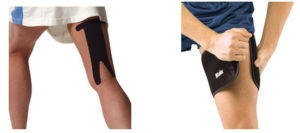A Hamstring Strain is a Common Leg Injury involving a tear in one or more of the hamstring muscles. A hamstring strain can range from mild to very severe involving a complete tear of the hamstring muscle.
The hamstring muscle group comprises 3 muscles: semimembranosus and semitendinosus medially (inner side of the thigh) and biceps femoris – short and long heads laterally (outer side of the thigh).
Causes of a Hamstring Strain
The reasons for a Hamstring strain or injury can be categorized into primary or secondary.
Primary:
Poor coordination and firing time of front and back muscles of the thigh. The simultaneous eccentric and concentric contraction in the hamstring muscles during the switch between late leg recovery and initial leg approach in the swing phase of sprinting.
Secondary:
- Poor running mechanics – If runners over-striding or have poor pelvic control, it will put the hamstrings in a vulnerable position at ground contact.
- Improper warm-up – Proper warm-up is needed to prepare the hamstring muscles. Passive stretching is only one segment of warm-up.
- Inappropriate overloaded training – Hamstrings are primarily composed of fast-twitch Type II fibers that tire up relatively early. Hence High-speed work should be done early during workouts.
- Fatigue – if proper recovery time is not given, it may strain the hamstring.
- Lower back pathology – Lower back anomalies cause nerve dysfunction and subsequent muscle weakness which can predispose hamstring to injury.
- Playing surfaces – A wet slippery surface puts more strain on the hamstring.
Symptoms of a Hamstring Strain
Mild hamstring strains are more like low-grade ache or tightness in the hamstring region (back of thigh). Severe hamstring strains can be quite devastating ranging from excruciating pain to making it difficult to walk or even stand.
Other symptoms may include:
- Severe pain during exercise, along with a snapping or popping feeling.
- Pain may range from the lower buttock region to hamstring insertion.
- Pain with bending and straightening of the leg or while bending over like touching the toes.
- Tenderness over the hamstring belly.
- Bruising.
Diagnosis
A well-trained physiotherapist will observe/ examine signs of pain on hamstring contraction against resistance, compromised hamstring flexibility, tenderness, or a palpable lump or gap within the hamstring muscle bulk. Pulled hamstrings are graded into 3 types depending on severity.
Ultrasound scan and MRI can be used to identify the location and extent of a hamstring tear.
- Grade 1 Hamstring Strain
With a grade 1 hamstring strain, there is tightness in the back of the thigh but the patient will be able to walk normally. The patient is aware of some hamstring discomfort and will be unable to run at full speed. There may be mild swelling and spasms. Bend your knee against resistance is unlikely to reproduce much pain.
- Grade 2 Hamstring Strain
With a grade 2 hamstring strain, the walking pattern will be affected and the patient most likely is limping. Sudden twinges of hamstring pain during activity will be present. Noticeable hamstring muscle swelling and tenderness will be present. Knee bend against resistance will be painful.
- Grade 3 Hamstring Strain
A grade 3 hamstring strain is a severe injury involving a tear to half of all of the hamstring muscles. The patient may need crutches to walk and will feel severe pain and weakness in the muscle. Swelling will be noticeable immediately and bruising usually appears within 24 hours.
Treatment of Hamstring Strain
Many patients with a hamstring strain start to feel better within a few days of the injury. However, there is an extremely high hamstring re-injury rate due to a poor rehabilitation process.
Hamstring strain is one injury that needs professional guidance for both an accurate diagnosis and also to provide the best possible treatment to avoid a repeat of hamstring injuries.
Repeat hamstring injuries have unfortunately curtailed many budding athlete’s careers.
Aims of Physiotherapy Treatment:
- Reduce hamstring pain and inflammation.
- Normalise joint range of motion and muscular flexibility.
- Strengthening of knee muscles and hamstrings.
- Strengthening lower limb muscles: calves, hip, and pelvis muscles.
- Normalize lumbopelvic control and stability – a co-factor in many hamstring strains.
- Normalise neurodynamics to enable the sciatic nerve to pass freely without scar adhesions.
- Improve game speed, proprioception, agility, and balance.
- Improve lower limb techniques and function e.g. running, sprinting, jumping, hopping, and landing.
- Minimize chances of hamstring re-injury.
Kinesio-Taping
Physiotherapists may recommend thigh support or Kinesio-Taping for hamstring strains. It provides confidence, warmth, and proprioceptive feedback, which reduce the likelihood of hamstring re-injury.

Hamstring Surgery
Hamstring surgery is rarely required. It appears limited to complete ruptures or to remove scar tissue from chronic hamstring tears.
Prognosis
While every hamstring injury and the demands of sport differ, general strain recovery time when an optimal physiotherapist-guided rehabilitation program is implemented are as follows-
Grade 1 – 1 to 3 weeks
Grade 2 – 4 to 8 weeks
Grade 3 – 3 to 6 months. These may also require surgery.
For more information, please consult a Physiotherapist for Hamstring Strain in Dwarka, Delhi, or in your locality.





